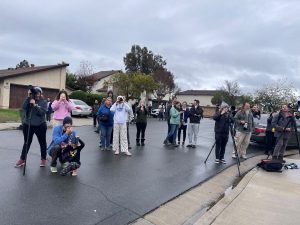Is it a New Year’s omen or simply a freak of nature? Perhaps only the Snowy Owl knows for sure.
Following what could be described as a mystery, freak of nature, or even an omen by some, in a once-in-a-century mystic event, a large, rare bird whose home is generally the Arctic tundra has found its way to Cypress this week, prompting a birdwatching frenzy and a global media sensation.
Not unlike the mysterious visit of the “Raven” that appears out of nowhere to the distraught lover in Edgar Allen Poe’s famous poem, a very large, rare, Arctic “Snowy Owl” somehow just showed up on a rooftop in Cypress this week, prompting a holiday vigil from birdwatchers and fueling speculation on social media.
Experts quoted in the media report have said there are as few as 30,000 such Snowy Owls remaining in the world today.
The darker markings on this elegant creature indicate the owl is female, the experts said. With its huge six-to eight-foot wingspan, has moved from rooftop to rooftop, yet the Snowy Owl remains in Cypress with no one being quite sure why.
Thus far, reports of the bird include sightings on homes on various streets including Saipan, Onyx, Pitcairn, Reefton Ave. and others.
The bird is thought to be feeding at the Joint Forces Training Base and the Los Alamitos Race Course.
Nevertheless, birdwatching has become all the rage around town.
“People [in Cypress] are excited to be visited by such a beautiful creature,” said Mayor Anne Hertz-Mallari, “and they’re watching the Snowy Owl and standing out there in the street and wondering, like the rest of us, why,” she said.
Hertz-Mallari said the city staff is aware of the Snowy Owl’s presence, but thus far, has not needed any specific support from the city or the police department.
She characterized residents, though mesmerized, as “quiet and respectful” of the bird and its watchers. “They shared their enthusiasm for spending time with the beautiful owl that has brought people together in such a positive way.”
News of the bird’s odd plight has become a global news story, even landing in The New York Times and the likes of “People Magazine,” among other media outlets. Hertz-Mallari said, “it is such a beautiful story, and people enjoy being positive at the beginning of a new year.”
The bird has been such a sensation that throngs of people, including professors, bird watchers, and regular people who are just curious have gathered in clumps, with long lenses and tripods seeking to record the bird’s every move.

Courtesy photo
“It’s been a bit crazy,” “said City Council member Frances Marquez, who has also followed the bird since it was first discovered in a neighborhood near her home. “It’s one of the coolest and most educational things to happen in Cypress since I was a kid,” the Council member posted on Facebook.
“The residents around Cypress have been very nice,” she said, sharing coffee and soft drinks with the throngs who gathered near the bird’s latest spots. She said the Snowy Owl leaves his perch on various rooftops and chimneys occasionally, but always comes back.
Other reports in a variety of local, regional, national, and international publications quoted local citizens and experts.
“I consider it an honor to be able to see the bird,” said Rob Young, who works with Santa Ana River Wildlife, just one of the many people who gathered in the Cypress neighborhood to admire the majestic bird. “Kinda put a feather in my cap so to speak, no pun intended.”
According to some familiar with the situation, the bird has been seen multiple times in recent days, flying from one rooftop to another.
Kasia Obrzut, a birder who made her way to the neighborhood early Wednesday, says anytime there’s a rare opportunity like this she has to take advantage.
Experts say that the bird’s appearance in Southern California is a mystery, especially due to the drastic difference from its traditional habitat. Yet, reports indicate the experts believe the Snowy Owl is healthy.
“The only thing it has to worry about here is there’s a lot more potential damage,” said local veterinarian Scott Weldy, who said he’s never heard of this specific bird flying so far south. “There are a lot more cars. We have power lines, the windmills. We have tons of things that traumatize flying birds here in Southern California.”
The ENE will monitor the Snowy Owl and present a more detailed report next week.

